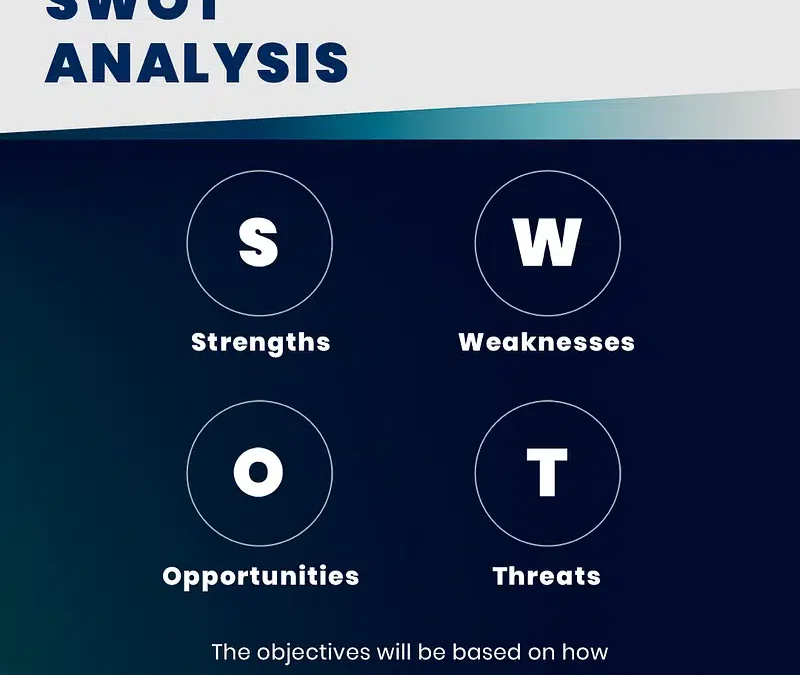What Is A Swot Analysis?
SWOT analysis is a valuable tool used in various ISO standards, including ISO 45001 (Occupational Health & Safety Management System) and ISO 9001 (Quality Management System). Let me break it down for you:
What Swot Stands For
Strengths: Internal factors that an organisation excels at.
Weaknesses: Internal factors that need improvement.
Opportunities: External factors that can benefit the organization.
Threats: External factors that pose risks to the organisation.
ISO 45001:
ISO 45001:2018 requires companies to identify top-level issues, risks, and opportunities. SWOT analysis helps achieve this.
It’s used to identify internal strengths and weaknesses, as well as external opportunities and threats.
By assessing these factors, organisations can address current problems and develop future potential.
Three ISO 45001 clauses where SWOT analysis is relevant:
Understanding the organization and its context (clause 4.1): Identify internal and external issues.
Assessment of OH&S risks and other risks (clause 6.1.2.2): Evaluate threats.
Assessment of OH&S opportunities (clause 6.1.2.3): Consider opportunities for improvement.
ISO 9001:
SWOT analysis is also significant in ISO 9001.
It helps create a customised quality management system aligned with the organisation’s strategic direction and quality objectives.
ISO 9001:2015 emphasizes SWOT analysis under clause 4.1, focusing on client satisfaction.
Remember, SWOT analysis provides a holistic view, helping organisations make informed decisions and enhance their management systems.
Applying Swot Analysis In Your Organisation
Gather Information:
Collect data on internal factors (strengths and weaknesses) and external factors (opportunities and threats).
Engage with stakeholders, employees, and management to gain insights.
Identify Strengths and Weaknesses:
Strengths: What does your organisation excel at? Consider aspects like skilled workforce, efficient processes, or unique resources.
Weaknesses: What areas need improvement? Look at inefficiencies, gaps, or limitations.
Explore Opportunities And Threats
Opportunities: External factors that can benefit your organisation. Examples include market trends, emerging technologies, or new customer segments.
Threats: External risks that could harm your organisation. These might be competition, regulatory changes, or economic downturns.
Swot Matrix
Create a matrix with four quadrants: Strengths, Weaknesses, Opportunities, and Threats.
List items from your analysis in the relevant quadrant.
Strategic Planning:
Leverage the SWOT analysis to inform your strategic decisions.
Align strengths with opportunities to maximise growth.
Address weaknesses and mitigate threats.
Action Plans
Develop action plans based on the SWOT analysis.
Prioritise initiatives that capitalise on strengths and opportunities.
Mitigate weaknesses and prepare for potential threats.
Remember, SWOT analysis is a dynamic process. Regularly review and update it to adapt to changing circumstances. 🌟
How Often Should I Revised My Swot?
Revisiting your SWOT analysis is crucial for maintaining its relevance. Here are some guidelines:
Frequency:
Annually: Conduct a comprehensive review at least once a year.
Quarterly: Consider shorter reviews to adapt to changing circumstances.
Trigger Events: Revisit after significant events (e.g., mergers, market shifts).
Dynamic Process:
SWOT is not static; it evolves with your organisation.
Update when new data or insights emerge.
Strategic Planning:
Align SWOT findings with strategic decisions.
Adjust goals, priorities, and action plans accordingly.
Remember, adaptability ensures your SWOT analysis remains a valuable tool!
What Are Some Of The Pitfalls In Swot Analysis?
SWOT analysis, a strategic planning tool used to identify strengths, weaknesses, opportunities, and threats related to a business or project, has several common pitfalls that can undermine its effectiveness. Here are some of the most notable ones:
Lack of Focus:
Overly broad or vague elements can lead to a lack of actionable insights. It’s important to be specific and concise.
Bias and Subjectivity:
Personal biases or internal politics can influence the identification and assessment of SWOT elements. This can result in an unbalanced or skewed analysis.
Overemphasis on Strengths and Weaknesses:
Sometimes, too much focus is placed on internal factors (strengths and weaknesses) while neglecting external factors (opportunities and threats), or vice versa. A balanced approach is crucial.
Static Perspective:
Viewing SWOT elements as static rather than dynamic can be misleading. The business environment is constantly changing, and the analysis should be updated regularly.
Failure to Prioritise:
Listing too many factors without prioritizing them can overwhelm and dilute the analysis. Identifying the most critical elements is essential for actionable strategy development.
Lack of Follow-Through:
Completing the SWOT analysis without integrating its insights into strategic planning and decision-making processes renders it useless. There must be a clear path from analysis to action.
Ignoring External Opinions:
Relying solely on internal perspectives can result in a narrow view. Incorporating feedback from external stakeholders (e.g., customers, suppliers, industry experts) can provide a more comprehensive understanding.
Overlooking Interconnections:
Failing to recognise how strengths, weaknesses, opportunities, and threats interact can lead to incomplete or inaccurate strategies. It’s important to consider how these elements influence each other.
Complexity and Overanalysis:
Overcomplicating the analysis with excessive details can make it difficult to see the bigger picture. Keeping the analysis clear and manageable is vital.
Ignoring Industry Trends and Competitor Actions:
Not taking into account broader industry trends and competitor strategies can result in an incomplete analysis. Understanding the competitive landscape is crucial.
Not Involving the Right People:
Excluding key stakeholders or experts from the process can result in missed insights and perspectives. A collaborative approach ensures a more comprehensive analysis.
By being aware of these pitfalls, organisations can take steps to mitigate them and ensure that their SWOT analysis is effective and actionable.
Share


Recent Comments